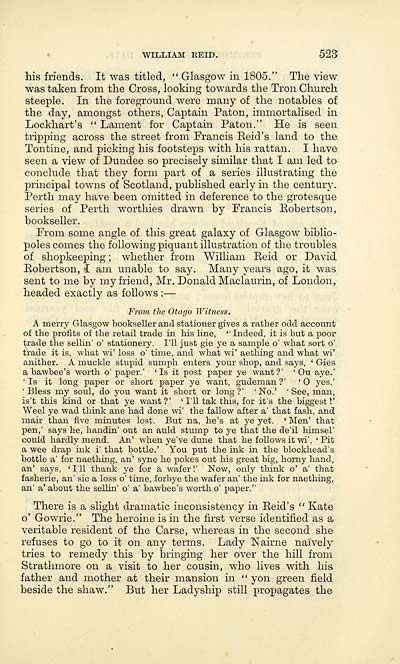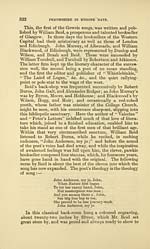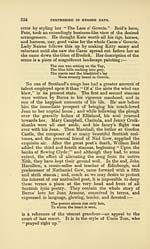Perthshire in bygone days
(551) Page 523
Download files
Complete book:
Individual page:
Thumbnail gallery: Grid view | List view

WILLIAM KEID. 523
his friends. It was titled, " Glasgow in 1805." The view
was taken from the Cross, looking towards the Tron Church
steeple. In the foreground were many of the notables of
the day, amongst others, Captain Paton, immortalised in
Lockhart's " Lament for Captain Paton." He is seen
tripping across the street from Francis Eeid's land to the
Tontine, and picking his footsteps with his rattan. I have
seen a view of Dundee so precisely similar that I am led to
conclude that they form part of a series illustrating the
principal towns of Scotland, published early in the century.
Perth may have been omitted in deference to the grotesque
series of Perth worthies drawn by Francis Bobertson,
bookseller.
From some angle of this great galaxy of Glasgow biblio-
poles comes the following piquant illustration of the troubles
of shopkeeping ; whether from William Eeid or David
Eobertson, i am unable to say. Many years ago, it was
sent to me by my friend, Mr. Donald Maclaurin, of London,
headed exactly as follows : —
From the Otago Witness.
A merry Glasgow bookseller and stationer gives a rather odd account
of the profits of the retail trade in his line, "Indeed, it is but a poor
trade the sellin' o' stationery. I'll just gie ye a sample o' what sort o'
trade it is, what wi' loss o' time, and what wi' aetliing and what wi'
anither. A rnuckle stupid sumph enters your shop, and says, ' Gies
a bawbee's worth o' paper.' 'Is it post paper ye want?' ' Ou aye.'
'Is it long paper or short paper ye want, gudeman?' '0 yes.'
' Bless my soul, do you want it short or long?' 'No.' 'See, man,
is't this kind or that ye want ?' ' I'll tak this, for it's the biggest !'
Weel ye wad think ane had done wi' the fallow after a' that fash, and
mair than five minutes lost. But na, he's at ye yet. ' Men' that
pen,' says he, handin' out an auld stump to ye that the de'il liimsel'
could hardly mend. An' when ye've dune that he follows it wi', ' Pit
a wee drap ink i' that bottle.' You put the ink in the blockhead's
bottle a' for naething, an' syne he pokes out Ms great big, horny hand,
an' says, 'I'll thank ye for a wafer!' Nov/, only tliink o' a' that
fasherie, an' sic a loss o' time, forbye the wafer an' the ink for naething,
an' a' about the sellin' o' a' bawbee's worth o' paper."
There is a slight dramatic inconsistency in Eeid's "Kate
o' Gowrie." The heroine is in the first verse identified as a
veritable resident of the Carse, whereas in the second she
refuses to go to it on any terms. Lady Nairne naively
tries to remedy this by bringing her over the hill from
Strathmore on a visit to her cousin, who lives with his
father and mother at their mansion in " yon green field
beside the shaw." But her Ladyship still propagates the
his friends. It was titled, " Glasgow in 1805." The view
was taken from the Cross, looking towards the Tron Church
steeple. In the foreground were many of the notables of
the day, amongst others, Captain Paton, immortalised in
Lockhart's " Lament for Captain Paton." He is seen
tripping across the street from Francis Eeid's land to the
Tontine, and picking his footsteps with his rattan. I have
seen a view of Dundee so precisely similar that I am led to
conclude that they form part of a series illustrating the
principal towns of Scotland, published early in the century.
Perth may have been omitted in deference to the grotesque
series of Perth worthies drawn by Francis Bobertson,
bookseller.
From some angle of this great galaxy of Glasgow biblio-
poles comes the following piquant illustration of the troubles
of shopkeeping ; whether from William Eeid or David
Eobertson, i am unable to say. Many years ago, it was
sent to me by my friend, Mr. Donald Maclaurin, of London,
headed exactly as follows : —
From the Otago Witness.
A merry Glasgow bookseller and stationer gives a rather odd account
of the profits of the retail trade in his line, "Indeed, it is but a poor
trade the sellin' o' stationery. I'll just gie ye a sample o' what sort o'
trade it is, what wi' loss o' time, and what wi' aetliing and what wi'
anither. A rnuckle stupid sumph enters your shop, and says, ' Gies
a bawbee's worth o' paper.' 'Is it post paper ye want?' ' Ou aye.'
'Is it long paper or short paper ye want, gudeman?' '0 yes.'
' Bless my soul, do you want it short or long?' 'No.' 'See, man,
is't this kind or that ye want ?' ' I'll tak this, for it's the biggest !'
Weel ye wad think ane had done wi' the fallow after a' that fash, and
mair than five minutes lost. But na, he's at ye yet. ' Men' that
pen,' says he, handin' out an auld stump to ye that the de'il liimsel'
could hardly mend. An' when ye've dune that he follows it wi', ' Pit
a wee drap ink i' that bottle.' You put the ink in the blockhead's
bottle a' for naething, an' syne he pokes out Ms great big, horny hand,
an' says, 'I'll thank ye for a wafer!' Nov/, only tliink o' a' that
fasherie, an' sic a loss o' time, forbye the wafer an' the ink for naething,
an' a' about the sellin' o' a' bawbee's worth o' paper."
There is a slight dramatic inconsistency in Eeid's "Kate
o' Gowrie." The heroine is in the first verse identified as a
veritable resident of the Carse, whereas in the second she
refuses to go to it on any terms. Lady Nairne naively
tries to remedy this by bringing her over the hill from
Strathmore on a visit to her cousin, who lives with his
father and mother at their mansion in " yon green field
beside the shaw." But her Ladyship still propagates the
Set display mode to:
![]() Universal Viewer |
Universal Viewer | ![]() Mirador |
Large image | Transcription
Mirador |
Large image | Transcription
Images and transcriptions on this page, including medium image downloads, may be used under the Creative Commons Attribution 4.0 International Licence unless otherwise stated. ![]()
| Histories of Scottish families > Perthshire in bygone days > (551) Page 523 |
|---|
| Permanent URL | https://digital.nls.uk/94913010 |
|---|
| Description | A selection of almost 400 printed items relating to the history of Scottish families, mostly dating from the 19th and early 20th centuries. Includes memoirs, genealogies and clan histories, with a few produced by emigrant families. The earliest family history goes back to AD 916. |
|---|

